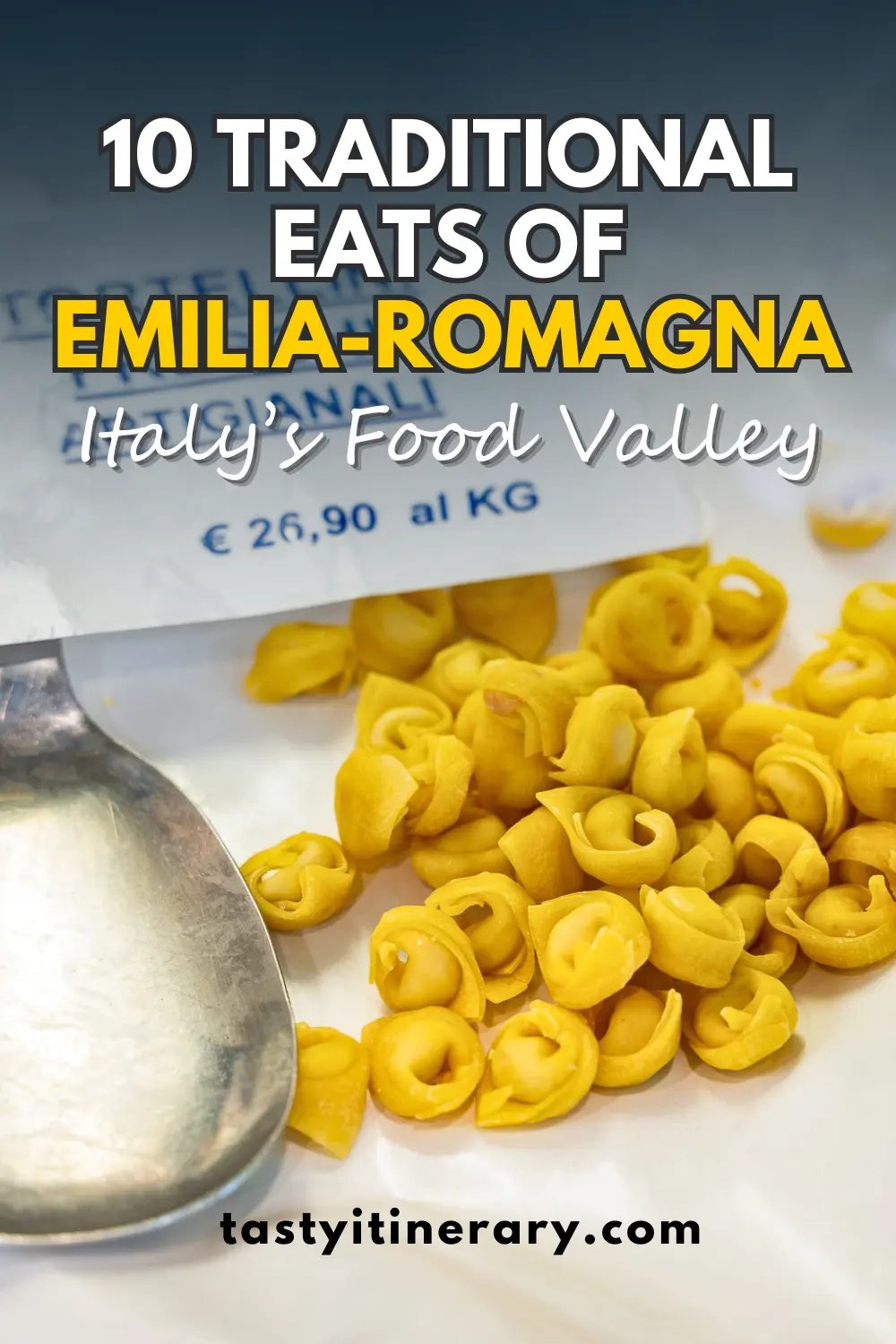10 Traditional Foods of Emilia-Romagna You Need to Try
What are the foods of Emilia-Romagna, and what makes this region the foodie capital of Italy? Emilia-Romagna, in northern Italy, is the birthplace of some of the most iconic dishes and ingredients in Italian cuisine. From silky ribbons of tagliatelle to delicate tortellini and the world-renowned Parmigiano Reggiano, this region’s culinary traditions have shaped Italian food culture worldwide.
Between Tuscany, Lombardy, and Veneto, Emilia-Romagna is home to cities like Bologna, Parma, and Modena, where food isn’t just a part of life—it’s a passion. Known as Italy’s “food valley,” the region celebrates fresh, local ingredients and time-honored recipes.
After hearing about the legendary Emilia-Romagna foods, we finally made it there to experience them ourselves. Every meal, from rich pasta dishes to perfectly aged Parmigiano Reggiano and flavorful cured meats, reflected the dedication to quality and tradition that defines this region.

Disclaimer: This post may contain affiliate links, meaning we earn a commission at no extra cost. Please refer to our full disclosure for details.
In this article, we’ll explore 10 traditional eats that define Emilia-Romagna cuisine, where they come from, and why they’re a must-try for any food lover.
Traditional Foods of Emilia-Romagna
Emilia-Romagna is known for dishes that reflect its deep culinary heritage. Let’s explore the must-try foods from this incredible region.
1. Tortellini
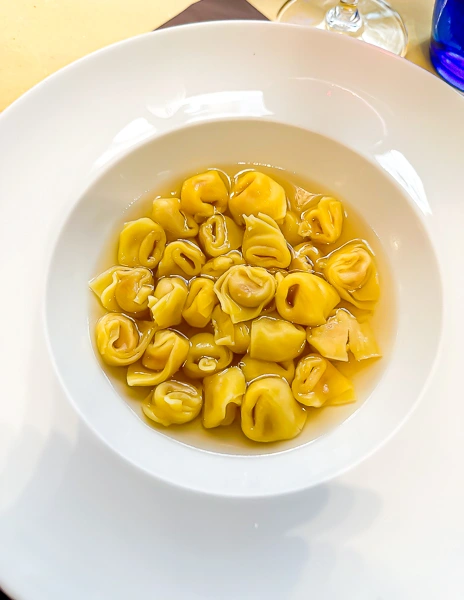
Tortellini is one of Emilia-Romagna’s most iconic dishes, originating from Bologna and Modena. This delicate, handmade pasta is traditionally stuffed with a mix of pork, mortadella, and Parmigiano Reggiano. The shape said to resemble the navel of the goddess Venus, is part of its charm and legend.
One of the most classic preparations is tortellini en brodo—served in a flavorful broth—but it’s not the only way to enjoy it. Tortellini is also served with rich tomato sauces, cream-based sauces, or even simply with butter and sage. Each preparation highlights the pasta’s delicate texture and flavorful filling.
We had the chance to try tortellini in Bologna and Modena, each city bringing its own twist to the dish. During a food tour in Bologna, we even visited a small pasta factory where women expertly hand-rolled and shaped thousands of tortellini daily—a testament to the craftsmanship behind this beloved pasta.

Tour Ideas:
Bologna Food Tour from a Local Perspective [book here]
2. Tagliatelle al Ragù
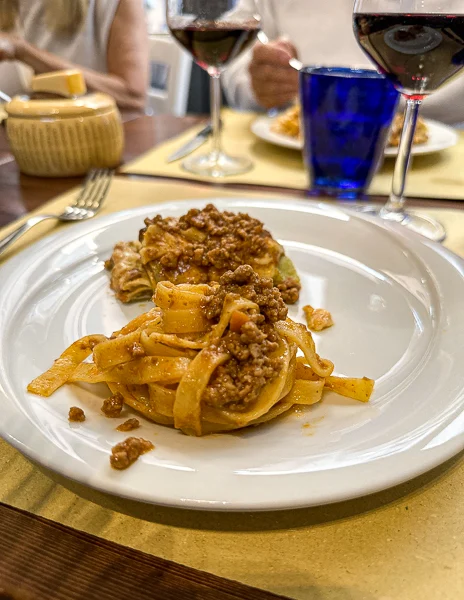
Most of us are familiar with spaghetti bolognese, but the version we know barely resembles Bologna’s authentic Tagliatelle al ragù. This classic dish, originating in Bologna, is a staple throughout Emilia-Romagna.
Tagliatelle is a flat, long pasta similar to fettuccine. It’s paired with a slow-cooked ragù—a rich sauce made with ground meat and tomatoes. Each restaurant has its own recipe and proudly claims itss is the best, making it nearly impossible to pick a favorite.
If you’re visiting Bologna, ordering ragù at every opportunity is worth it. If a trip isn’t in the cards, you can bring a taste of Emilia-Romagna cuisine home by trying La Cucina Italiana’s traditional Tagliatelle al Ragù recipe.
3. Parmigiano Reggiano

Parmigiano Reggiano DOP, one of the world’s most famous cheeses, is produced exclusively in Emilia-Romagna, primarily in Parma, Reggio Emilia, and parts of Modena and Bologna. This iconic cow’s milk cheese originated in Parma and is celebrated for its nutty, salty flavor and crumbly texture.
The cheese undergoes a minimum aging process of 12 months, commonly found at 24, 36, or even more months of ripening. As it ages, the flavor becomes nuttier, and the texture hardens. It’s no wonder the 24-month Parmigiano Reggiano is perfect for grating over pasta.
Fun Fact: The “DOP” (Protected Designation of Origin) label means Parmigiano Reggiano must meet strict regulations to carry the name. If it’s labeled DOP, you know it’s the real deal.
Read more: How to Enjoy a Day in Parma, Italy
Tour Ideas:
Private Half-Day Parma Food Walking Tour [book here]
Parmigiano Reggiano Cheese Tasting Tour [book here]
4. Aceto Balsamico Tradizionale DOP

Aceto Balsamico Tradizionale DOP, another iconic product of Emilia-Romagna, holds Protected Designation of Origin status. Made in Modena and Reggio Emilia, this traditional balsamic vinegar is nothing like the mass-produced version you might drizzle on a salad.
The real deal is crafted from local grape must (cooked-down juice), then aged in wooden casks for 12 to 100 years. As it matures, the flavors deepen, and the texture thickens, making it truly unique. The longer it’s aged, the more expensive it becomes—and the more intense its flavor.
If you’re visiting Modena or the Emilia-Romagna region, a balsamic vinegar tasting tour is a must. You’ll learn how the age, grape varieties, and wooden barrels influence the flavors. Locals save the precious DOP bottles for special occasions, but there are plenty of excellent non-DOP options for everyday use.
Different ages of balsamic are used for different dishes. As a finishing touch, drizzle Aceto Balsamico Tradizionale over gelato, pasta, or meat. A little goes a long way, and every drop feels like liquid gold. For cooking or salads, opt for regular balsamic vinegar instead.
Tour Ideas:
Tour Oldest Balsamic Vinegar Company in Modena [book here]
Discovering the Balsamic Vinegar of Modena [book here]
5. Prosciutto di Parma
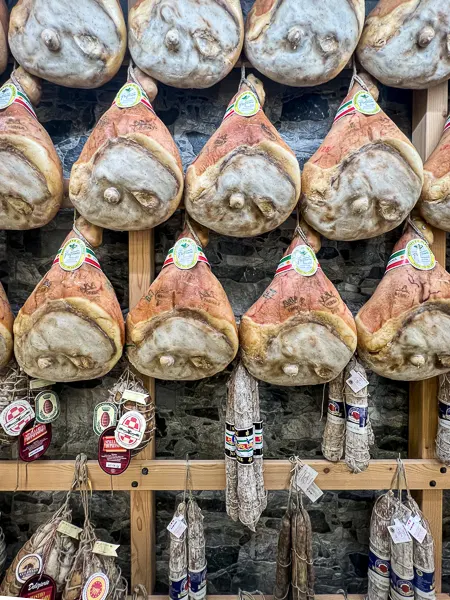
Prosciutto di Parma is one of Emilia-Romagna’s most iconic foods and a staple of Italian cuisine. This DOP-certified delicacy is produced in Parma, where it’s crafted from select pork breeds raised locally and cured with precision.
Made from the hind legs of pigs, Prosciutto di Parma is air-dried, salted, and aged for 12 to 24 months. The process creates a tender yet firm texture and a flavor that balances savory and delicate notes. While prosciutto is made in other parts of Italy, only Parma’s can carry the DOP label, ensuring it meets the highest standards.
During our visit, the prosciutto we tried in Parma stood out from versions we’d tasted elsewhere. Its tenderness and rich flavor made it a highlight of our Emilia-Romagna food experience, especially when paired with local cheese or fresh bread.
Tour Ideas:
Parmigiano Cheese and Parma Ham Tour [book here]
6. Gnocco Fritto (or Torta Fritta)

Gnocco fritto is one of Emilia-Romagna’s most beloved foods, though its name varies depending on the city. In Modena, it’s called gnocco fritto; in Parma, it’s known as torta fritta; and in Bologna, it’s referred to as crescentina.
This light, crispy, and airy fried dough is usually served with salumi, cheeses, or other accompaniments. It’s commonly enjoyed as an appetizer or as part of a larger meal. During our visit to Modena, we even tried gnocco fritto for breakfast, dipping it into a cappuccino—a surprising yet delightful combination we didn’t expect to love.
Despite its variations in name, this dish remains a quintessential part of Emilia-Romagna’s food culture. Whether you call it gnocco fritto, torta fritta, or crescentina, one thing is certain: it’s delicious.
7. Tigelle
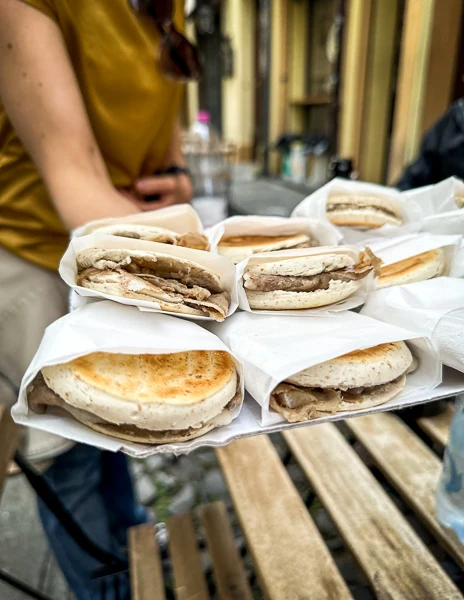
Tigelle is another popular food of Emilia-Romagna. It is a small, round flatbread made with wheat flour, yeast, olive oil, and salt. Traditionally, the dough is pressed using terracotta tiles designed specifically for tigelle.
Served warm, tigelle is typically sliced in half and filled with salumi like mortadella or prosciutto, local cheeses, or sweet spreads and pestos. This versatile bread is one of the oldest recipes in the region, with each town offering its own variation.
Tigerelle is a popular street food and is also on dinner menus, making it an essential part of Emilia-Romagna’s culinary tradition.
8. Culatello di Zibello

Before visiting Emilia-Romagna, we hadn’t heard of the region’s Culatello di Zibello, an exclusive salumi. This DOP-certified delicacy is made from the deboned thigh muscles of the pig, similar to prosciutto di Parma, but cured in the small village of Zibello in Parma province, where the unique humidity creates ideal aging conditions.
The flavor of Culatello di Zibello is more intense than prosciutto—delicate, soft, and deeply savory. We had the chance to try it at a local salumeria and couldn’t resist bringing some home, vacuum-packed for freshness.
Due to its high cost, Culatello di Zibello is one of Emilia-Romagna’s most prized products. It is typically reserved for holidays or special occasions, and it’s rarely exported, so tasting it locally is a unique experience.
Tour Ideas:
Culatello and Parmigiano: Private Half-day Tour With Lunch in Parma [book here]
9. Mortadella
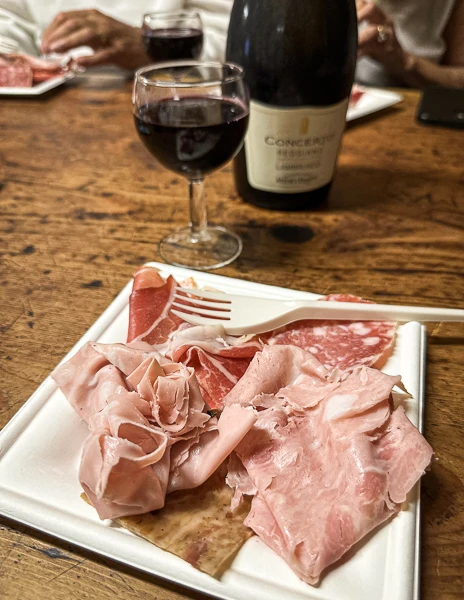
Mortadella, a staple of Emilia-Romagna, might remind you of its distant cousin, the American “baloney,” but the two couldn’t be more different. This large, tender sausage is made from finely ground pork, spices, pistachios, and visible cubes of fat, resulting in a texture and flavor that are worlds apart from what is sold in U.S. delis.
Originating in Bologna, mortadella is produced throughout Emilia-Romagna and is best enjoyed freshly sliced. If you’ve never been a fan of baloney, mortadella might surprise you—it’s flavorful, high-quality, and worth a try.
10. Lambrusco
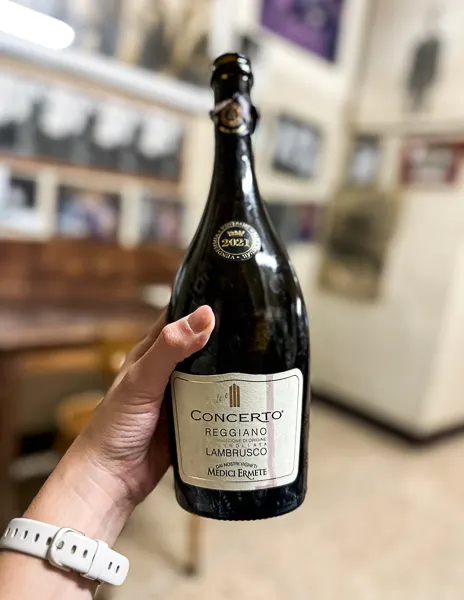
Regarding Emilia-Romagna drinks, Lambrusco is a must-try. This sparkling red wine is made from grapes grown in the Emilia-Romagna countryside and comes in three varieties: sweet, semi-sweet, and dry.
Vineyards produce Lambrusco in different styles, so it’s worth sampling a few. Our first taste didn’t impress us—the flavor felt flat. Later, though, we were served a higher-quality bottle with bolder, more complex flavors, which completely changed our opinion.
Typically served cold, Lambrusco pairs wonderfully with gnocco fritto, salumi, and tigelle.
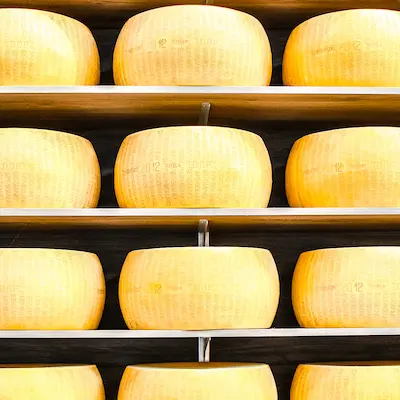
What Foods are Grown in Emilia-Romagna?
Emilia-Romagna produces many agricultural products, including corn, wheat, fodder, and sugar beets.
What Does Emilia-Romagna Produce?
Emilia-Romagna is known for producing a variety of cured meats like salami, prosciutto, and culatello. It’s also home to Parmigiano Reggiano, the world’s best Parmesan cheese.
What Food Is Emilia-Romagna Famous For?
Some famous Emilia-Romagna foods include Parmigiano Reggiano cheese, Prosciutto di Parma, Aceto Balsamico di Modena, and Ragù (Bolognese sauce). These staples of Italian cuisine have become beloved worldwide.
BEFORE YOU TRAVEL TO ITALY, CHECK OUT THESE RELATED READS:
Kathy Ava
Meet Kathy Ava, a food, travel, and cruise writer based in Los Angeles/Pasadena, and the owner and main writer of Tasty Itinerary. With over 20 years of experience planning trips and logistics at her full-time job and for herself, she's become a pro at crafting unforgettable tasty itineraries. She's always on the hunt for delicious, fun travel destinations and cruise itineraries. She firmly believes that life is short and we must make the most of it, so always say yes to dessert.

